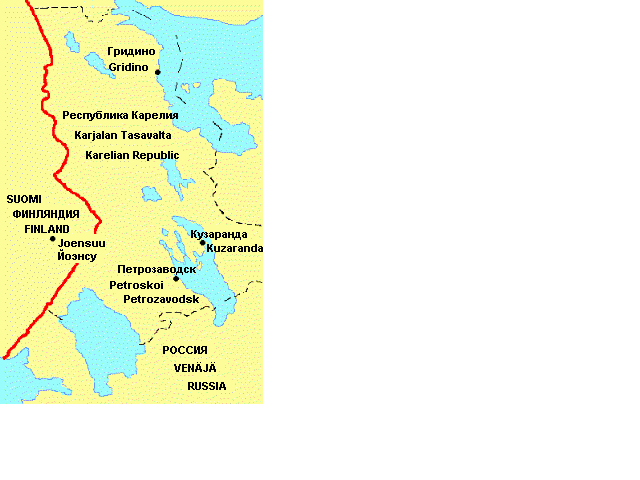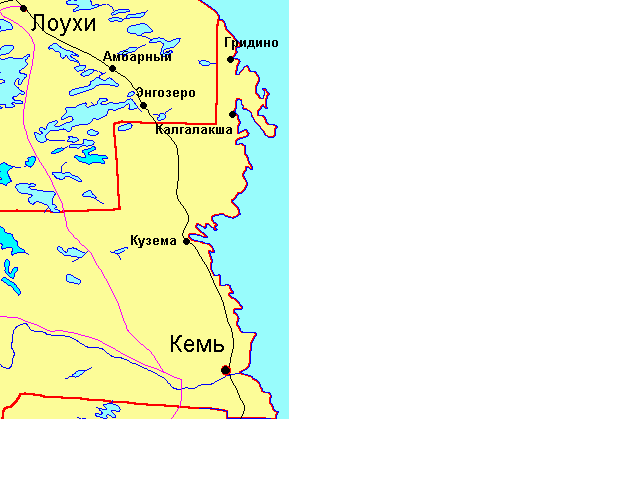![]()
Obrazcy sovremennyh russkih govorov Karelii
Suomi / English / Vybor russkoj kodirovki: UNIX KOI8-R / WINDOWS CP 1251
Samples of contemporary Russian dialects in Karelia
![]()
 Kuzaranda
Kuzaranda
An agreement on scientific cooperation and student exchange between the universities of Joensuu and Petrozavodsk was signed in May 1986. As a result of this agreement, in July 1988 four students from the Russian department of the University of Joensuu had an opportunity to take part in field work organized by the University of Petrozavodsk. Katariina Jeskanen and Sari Riihiaho worked in the Karelian village of Kotkozero (the Olonec district of the Karelian Republic). They interviewed bilingual speakers of Karelian and Russian. Sari Dufva and Jaana Mustonen worked in Kuzaranda (the Medvezhegorsk district of the Karelian Republic) together with students of Russian language from Petrozavodsk. Over a period of one week, they recorded more than 12 hours of the local North Russian dialect. The experiences of the students are depicted in their travel report (in Finnish).
Kuzaranda is a traditional North Russian village, already mentioned in historical sources at the middle of the XV century. Before the arrival of the Russians, Balto-Finnic tribes - ancestors of the present-day Vepsians and Karelians - were living there. This is evidenced also by the name of the village. An article by V.P Kuznecova and I.I. Mullonen "Kuzaranda - the Shore of Fir Trees" tells about it in more detail.
 The
long-standing coexistence of Russian and Balto-Finnic inhabitants resulted
in the formation of the peculiar North Russian dialect of Zaonezh'e
(a peninsula in the north-western part of Lake Onego), characterized by
specific features such as ljapan'e (systematic shift of the word
stress to the first syllable or preposition). In a larger context, Zaonezh'e
is regarded as a part of the Olonec Russian dialects. The present state
of the local dialect is portrayed by the samples recorded in Kuzaranda
from four informants:
The
long-standing coexistence of Russian and Balto-Finnic inhabitants resulted
in the formation of the peculiar North Russian dialect of Zaonezh'e
(a peninsula in the north-western part of Lake Onego), characterized by
specific features such as ljapan'e (systematic shift of the word
stress to the first syllable or preposition). In a larger context, Zaonezh'e
is regarded as a part of the Olonec Russian dialects. The present state
of the local dialect is portrayed by the samples recorded in Kuzaranda
from four informants:
Three tales written down by A.A. Shahmatov in 1884 in the neighbouring village of Tolvuja are given as comparative material:†Russian code page UNIX KOI8-R / WINDOWS†CP 1251
 Literature
on the ethnic history, oral folklore and dialect of Zaonezh'e
Literature
on the ethnic history, oral folklore and dialect of Zaonezh'e

 Gridino
Gridino
In July 1990 two researchers from the Russian department of the University of Joensuu, Anneli Sarhimaa and Lea Siilin took part in a dialectological expedition to the village of Gridino (the Kem' district of the Karelian Republic), organized by the University of Petrozavodsk. Over the period of one week they recorded approximately 10 hours of dialect samples.
Gridino is a small fishing village on the western coast of the White Sea known as Karel'skoe Pomor'e. The local inhabitants, Pomors, are descendants of the Russian Old Believers who fled to the North from religious persecution in the XVII century. According to tradition, many contemporary Pomor villages were inhabited by Karelians even until the XIX century. In this respect, one can mention the famous Russian storyteller M.M. Korguev from the village of Keret', whose mother was Karelian and who also spoke Karelian himself ("Skazki Karel'skogo Belomor'ja", Petrozavodsk 1939).
Even though contemporary villagers in Gridino stress that they are "Russian Pomors", many features of the local dialect give evidence of a Balto-Finnic substratum or, at least, existence of close ties with the Karelians. In the past, Pomors also used to have contacts with the Lapps. This is evidenced by the Lappish loan words related to the nature and the means of livelihood (fishing, reindeer management).
Dialect samples recorded in Gridino will be added onto these pages later.
Transcription
The dialect samples are displayed in a simplified transcription that follows the main rules of the Russian orthography. Only the most striking phonetic features that can be used in making conclusions about the level of preservation of the traditional local dialect have been specifically noted. Examples of such features are the remains of the palatalized cokan'e and the ancient jat', the pronunciation of shch, reduction of verbs and adjectives. A part of the dialectal features that appear or have been ignored in the transcription have been specified in the descriptions of the informants.
Word stress has been marked with a colon (":") in cases where its place or the writing of the word differs from the literary language. Besides the stressed vowel, in a few cases the Russian letter "Ž" marks a specific dialectal feature, the transformation of an unstressed e into o (eg., mo:rŽ 'sea'; here the stress is marked by a colon).
The rhythm and intonation of the speech is indicated by the signs "/", "..." (in the middle of a sentence) and "//", "!", "?" (at the end of a sentence). Direct quotations found in the speech of the informants have been put in quotation marks. Three dashes (---) refer to a gap in the text. The questions and comments of the interviewer and other persons have been set in boldface.
This simplified transcription can be best used for examining morphological and syntactic features. A short fragment of speech from each informant is also given as a voice file: Russian code page UNIX†KOI8-R /†WINDOWS CP 1251.
The transcription has been prepared by Vladimir and Elena Panov and Esa Anttikoski.
Comments to dialectal words
Dialectal words found in the texts have been supplied with separate comments. The following lexicographical sources were used in their preparation:
Technical notes
These web pages have been created by Esa Anttikoski with Netscape Navigator 3.01 Gold and the HTML-editor of the AMSD Ariadna 1.2 beta browser. Juhani Luhtanen has kindly assisted with photographs and voice files.
The front page and the descriptions of the villages where the fieldwork was done can be read in English, Russian and Finnish. The Russian pages are available in the UNIX KOI8-R and WINDOWS CP 1251 encodings. Some fonts may distort the Russian letter "Ž" (jo) and the sign of the asyllabic "u".
The following characters based on the Latin alphabet have been replaced by letter combinations:
If you have problems in russifying your browser, you may find help from "Russify Everything" by Vadim Maslov.
We would appreciate your questions and comments!
Send them to:
Muusa Savijšrvi, Professor, Muusa.Savijarvi@joensuu.fi
Esa Anttikoski, Esa.Anttikoski@joensuu.fi
Department of Russian, University of Joensuu, P.O. Box 111, FIN-80101 Joensuu, FINLAND